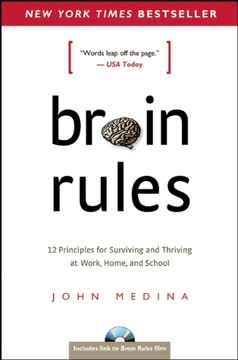Key Takeaways
1. The Prefrontal Cortex: Your Brain's Limited Resource
"Your prefrontal cortex is the biological seat of your conscious interactions with the world."
Energy-hungry and small. The prefrontal cortex, responsible for complex thinking and decision-making, consumes a disproportionate amount of energy compared to its size. It's only about 4-5% of the brain's volume but uses significantly more resources.
Limited capacity. This region can only handle a few pieces of information at once, typically around four. This limitation affects our ability to multitask, make decisions, and solve problems effectively.
Key implications:
- Prioritize important tasks when your prefrontal cortex is fresh (usually in the morning)
- Take regular breaks to allow this region to recharge
- Be mindful of decision fatigue, especially later in the day
2. Simplify and Chunk Information for Better Processing
"Simplify information by approximating and focusing on an idea's salient elements."
Simplification techniques. Breaking down complex information into simpler, more manageable parts helps the brain process it more effectively. This can be done by focusing on core concepts and eliminating unnecessary details.
Chunking strategy. Grouping related pieces of information into "chunks" allows the brain to handle more information efficiently. This technique is especially useful for remembering and working with large amounts of data.
Examples of chunking:
- Grouping phone numbers into sets of 3 or 4 digits
- Organizing tasks by project or theme
- Categorizing items in a list by type or priority
3. The Myth of Multitasking: Focus on One Task at a Time
"When you focus on problems you are more likely to activate the emotions connected with those problems, which will create greater noise in the brain."
Serial processing. The brain is designed to focus on one conscious task at a time. Attempting to multitask often leads to decreased performance and increased errors.
Task-switching costs. Rapidly switching between tasks consumes additional mental resources and can lead to mental fatigue. This "switch cost" can significantly reduce overall productivity.
Strategies for focused work:
- Use time-blocking techniques to dedicate uninterrupted periods to specific tasks
- Minimize distractions by turning off notifications and creating a conducive work environment
- Practice mindfulness to improve concentration and reduce mind-wandering
4. Managing Distractions: External and Internal
"Labeling an emotion can reduce limbic system arousal."
External distractions. These include notifications, interruptions from colleagues, and environmental factors. Minimizing these can significantly improve focus and productivity.
Internal distractions. These are thoughts, worries, or impulses that divert attention from the task at hand. Managing these requires self-awareness and mental discipline.
Techniques for managing distractions:
- Use the "pomodoro technique" to work in focused bursts with scheduled breaks
- Practice mindfulness meditation to improve attention control
- Employ the "two-minute rule" for quick tasks to prevent them from becoming distractions later
5. The Goldilocks Zone of Mental Performance
"Peak mental performance requires just the right level of stress, not minimal stress."
Optimal arousal. The brain performs best in a state of moderate arousal – not too relaxed and not too stressed. This "sweet spot" varies between individuals and tasks.
Managing arousal levels. Understanding how to regulate your mental state can help you achieve and maintain peak performance.
Strategies for finding your optimal state:
- Practice stress-management techniques like deep breathing or progressive muscle relaxation
- Use positive self-talk and visualization to boost confidence and focus
- Experiment with different levels of challenge to find your personal "sweet spot"
6. Overcoming Mental Blocks: The Power of Insights
"Insights occur more frequently the more relaxed and happy you are."
Nature of insights. Insights are sudden realizations that often come when the mind is relaxed and not actively focusing on a problem. They involve making new connections between existing information.
Facilitating insights. Creating the right mental conditions can increase the likelihood of having insights and breakthrough ideas.
Tips for encouraging insights:
- Allow for periods of mental rest and relaxation
- Engage in activities that promote a positive mood
- Expose yourself to diverse ideas and experiences to create new mental connections
7. Emotional Regulation: Labeling and Reappraisal
"Reappraisal is a powerful strategy for managing increased arousal."
Labeling emotions. Putting words to your emotional experiences can help reduce their intensity and allow for more rational thinking.
Cognitive reappraisal. This involves changing your interpretation of a situation to alter its emotional impact. It's a powerful tool for managing stress and maintaining emotional balance.
Steps for effective reappraisal:
- Recognize the emotion you're experiencing
- Identify the thoughts or beliefs driving that emotion
- Challenge those thoughts and consider alternative perspectives
- Choose a more balanced or helpful interpretation
8. The Social Brain: Managing Relationships and Status
"Status is a significant driver of behavior at work and across life experiences."
Social needs as primary. The brain treats social needs, such as status and belonging, with the same importance as physical survival needs.
SCARF model. This model outlines five key social domains that drive behavior: Status, Certainty, Autonomy, Relatedness, and Fairness.
Applying the SCARF model in interactions:
- Status: Recognize and acknowledge others' contributions
- Certainty: Provide clear expectations and communication
- Autonomy: Allow for choice and input in decision-making
- Relatedness: Foster a sense of belonging and teamwork
- Fairness: Ensure equitable treatment and transparent processes
9. Facilitating Change in Others: Beyond Feedback
"Feedback creates a strong threat for people in most situations."
Limitations of feedback. Traditional feedback often triggers a threat response, making it less effective for creating lasting change.
Facilitating insights. Helping others arrive at their own realizations is often more powerful than direct instruction or criticism.
Techniques for facilitating change:
- Ask open-ended questions that promote self-reflection
- Create a safe environment for exploration and learning
- Focus on solutions and future possibilities rather than past problems
10. Mindfulness: The Key to Self-Awareness and Brain Control
"Your capacity to change yourself, change others, and even change the world, may boil down to how well you know your brain, and your capacity to consciously intervene in otherwise automatic processes."
Cultivating awareness. Mindfulness practices help develop the ability to observe your own mental processes, allowing for greater control over thoughts, emotions, and behaviors.
Neuroplasticity. Regular mindfulness practice can lead to physical changes in the brain, improving emotional regulation, attention, and decision-making capabilities.
Benefits of mindfulness practice:
- Enhanced emotional regulation
- Improved focus and attention
- Better stress management
- Increased cognitive flexibility
- Greater self-awareness and insight
Last updated:
FAQ
What's Your Brain at Work about?
- Focus on Brain Function: The book explores how understanding brain functions can enhance productivity and decision-making at work. It uses characters Emily and Paul to illustrate common workplace challenges.
- Neuroscience Insights: It delves into the latest neuroscience findings, explaining how the brain processes information, manages emotions, and makes decisions.
- Practical Strategies: Provides actionable strategies for improving focus, managing distractions, and facilitating collaboration to enhance work performance and well-being.
Why should I read Your Brain at Work by David Rock?
- Improve Work Performance: Offers scientifically-backed strategies to enhance performance by understanding and optimizing brain function.
- Accessible Science: Presents complex neuroscience concepts in an engaging manner, making them easy to grasp and apply.
- Broader Life Benefits: Insights can improve personal relationships and mental health, leading to better emotional regulation and decision-making.
What are the key takeaways of Your Brain at Work?
- Understanding Brain Limitations: Emphasizes the brain's limited capacity for processing information and making decisions, helping manage workload effectively.
- Importance of Focus: Highlights the need to prioritize tasks and focus on one thing at a time to maximize productivity.
- Emotional Regulation Techniques: Provides techniques for managing emotions, such as labeling feelings and using reappraisal to maintain clarity under pressure.
What is the SCARF model in Your Brain at Work?
- Five Domains: SCARF stands for Status, Certainty, Autonomy, Relatedness, and Fairness, which influence human behavior.
- Status Importance: Status is a significant driver of behavior, and threats to it can lead to defensive reactions.
- Application in Workplaces: Leaders can use the SCARF model to enhance employee engagement and collaboration by addressing social needs.
How does Your Brain at Work explain the concept of multitasking?
- Multitasking Reduces Performance: While people may believe they can multitask effectively, it actually decreases accuracy and cognitive performance.
- Cognitive Load: Discusses cognitive load, the mental effort used in working memory, which is stretched thin when multitasking.
- Focus on One Task: Advocates for focusing on one task at a time to improve efficiency and effectiveness.
What strategies does Your Brain at Work suggest for managing distractions?
- Eliminate External Distractions: Recommends turning off communication devices and creating a distraction-free environment for deep work.
- Mindfulness Practices: Encourages practicing mindfulness to enhance awareness of internal distractions and improve emotional regulation.
- Use of Visuals: Suggests using visuals to simplify complex information and reduce mental load.
How does Your Brain at Work define emotional regulation?
- Managing Emotional Responses: Described as the ability to manage and respond to emotional experiences effectively.
- Techniques for Regulation: Outlines techniques such as labeling emotions and cognitive reappraisal to manage emotional responses.
- Impact on Performance: Effective emotional regulation is crucial for maintaining focus and performance, especially under pressure.
What is the significance of the prefrontal cortex in Your Brain at Work?
- Central to Decision-Making: Responsible for complex decision-making, problem-solving, and emotional regulation.
- Energy-Intensive Function: Requires significant energy to operate effectively, which can be depleted through multitasking and distractions.
- Vulnerability to Stress: Can become overwhelmed by stress, leading to decreased performance; managing cognitive resources is essential.
How does Your Brain at Work address the concept of insights?
- Insights as Problem-Solving Tools: Describes insights as sudden realizations that help overcome mental roadblocks.
- Role of the Subconscious: Insights often arise from subconscious processing, suggesting stepping back from problems can facilitate creative thinking.
- Techniques to Foster Insights: Provides techniques such as taking breaks and practicing mindfulness to create conditions for insights.
How can I facilitate change in others according to Your Brain at Work?
- Focus on Insights: Emphasizes helping others find their own insights rather than providing direct feedback or solutions.
- Ask the Right Questions: Involves asking open-ended questions that guide others to reflect on their thinking processes.
- Create a Safe Environment: Establishing a safe environment reduces threats and increases rewards, encouraging exploration of new ideas.
What are the best quotes from Your Brain at Work and what do they mean?
- “Your ability to make great decisions is a limited resource.” Highlights that decision-making requires mental energy, which can be depleted.
- “The brain has an overarching organizing principle to minimize danger or maximize reward.” Emphasizes the brain's drive to seek safety and rewards, influencing behavior.
- “Mindfulness isn’t difficult: the hard part is remembering to be mindful.” Stresses the importance of self-awareness and the challenge of maintaining mindfulness.
How does Your Brain at Work address collaboration and teamwork?
- Social Needs: Highlights the importance of understanding social needs like relatedness and fairness in the workplace.
- Managing Expectations: Discusses how managing expectations within a team can lead to better cooperation and communication.
- Building Trust: Emphasizes the role of trust in effective teamwork, fostering an environment of fairness and open communication.
Review Summary
Your Brain at Work receives high praise for its practical insights on brain function and productivity. Readers appreciate the accessible presentation of neuroscience concepts through relatable scenarios. The book offers strategies for managing distractions, improving focus, and collaborating effectively. Many find it transformative, applying the techniques to enhance work performance and personal life. Some criticize the fictional narrative style, but most agree the content is valuable. Readers consistently recommend it as an essential guide for understanding and optimizing brain function in daily life.
Similar Books










Download PDF
Download EPUB
.epub digital book format is ideal for reading ebooks on phones, tablets, and e-readers.





